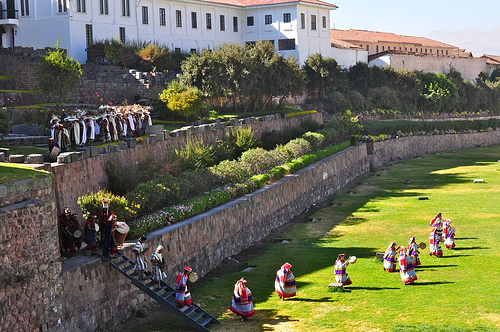More than 64,000 people celebrated Inti Raymi, the Festival of the Sun, at Saksayhuaman archaeological park, about 15 minutes from the city of Cusco.
The staging of Inti Raymi started at the temple of Coricancha with greetings for the Sun, and then it continued at the Main Square. It culminated in Saksaywaman with the ceremony itself.
The Inca, escorted by his wife (known as coya) and an entourage of more than 200 individuals, entered at around 2 PM into a platform set in the middle of the park, after walking across the stone fortifications. Diverse ceremonies were then held, like the rite to the chicha de jora [es], the fire and the sank’u, the Andean people's main meal.

Overview of Inti Raymi. Photo by Ayla Zanini on Flickr (CC BY-NC-ND 2.0).
June 24 marks the Southern Hemisphere's winter solstice; the shortest day and the longest night of the year. During the Inca era, the winter solstice marked the start of a new year, and according to 17-century writer and historian Inca Garcilaso de la Vega, it was the main celebration of the year.
In Cusco today, however, the date is more a show for tourists and also for locals, who consider the event a point of reference of their local conscience that stirs up enthusiasm and massive participation.
The website Toustodo's Blog explains [es] the following about the solstice:
Astronómicamente el solsticio es el momento en que el Sol alcanza la máxima declinación Norte (23° 27’) o Sur (-23° 27’) con respecto al ecuador terrestre.
En el hemisferio Norte el Sol alcanza el cenit en el solsticio de invierno al medio día sobre el Trópico de Capricornio, sucede el 20 o 21 de junio. En el hemisferio Sur el Sol alcanza su cenit al medio día sobre el Trópico de Cáncer, el 21 o 22 de junio.
Los solsticios se originan por la inclinación del eje de la Tierra sobre el plano de su órbita.
Astronomically, the solstice is the moment when the Sun reaches the highest declination North (23° 27’) or South (-23° 27’) in respect to the terrestrial equator.
In the Northern hemisphere the Sun reaches its zenith during the winter solstice at noon over the Tropic of Capricorn , which happens around June 20 or 21. In the Southern hemisphere the Sun reaches its zenith at noon over the Tropic of Cancer on June 21 or 22.
Solstices are originated by the inclination of the Earth's axis over the level of its orbit.
The blog Medios Alternativos shares part [es] of Inti Raymi's history:
Desde la conquista española, la ceremonia fue suprimida por la Iglesia Católica y la sociedad andina que celebraba la fiesta del sol fue desmembrada. El Inti Raymi fue entonces olvidado, hasta mediados del siglo XX cuando, como expresión de un gran movimiento de revaloración de la cultura nativa en el Perú, fue vuelto a la escena.
[…]
El Inti Raymi en tiempo de los Incas era una ceremonia religiosa, ahora es una representación de teatro, sin embargo esta expresión genera un sentimiento de identidad en el pueblo […]. La versión está expresada en el idioma original, quechua, con su correspondiente traducción al castellano para facilitar una mejor comprensión.
After the conquest by the Spaniards, the ceremony was suppressed by the Catholic Church and the Andean community that used to celebrate the sun festival was split up. Inti Raymi was then forgotten, until the mid 20th century when, as an expression of a great wave of revaluation of native culture in Peru, it was restored.
[…]
During the Inca era, Inti Raymi was a religious ceremony, now it is a theatrical representation, however, this expression generates a sense of identity in the people […]. The version is expressed in its original language, quechua, with a corresponding translation to Spanish for a better understanding.
On Twitter there were also comments related to the Festival of the Sun, like this one by Kristell PerezAlbela (@Kristellpa):
@Kristellpa: Quisiera estar en el #IntiRaymi !!
@Kristellpa [es]: I wish I could be at the #IntiRaymi !!
User SanBlasSpanishSchool (@SanBlasSpanish) expressed with enthusiasm:
@SanBlasSpanish: Yesterday was Inti Raymi, hope you all enjoyed it!
Meanwhile, Val (@Vientino) shared the beginning of the celebration:
@Vientino: Desde el amanecer de ayer se celebró la fiesta del sol, el Inti Raymi, en las estepas y las serranías de los Andes.
@Vientino [es]: From yesterday at dawn, the Festival of the Sun was celebrated, the Inti Raymi, at the plains and the highlands of the Andes.
Anyel (@AnyelZae) referred to the preference some parents have when choosing their children's name:
@AnyelZae: Pucha aveces los padres estan estresados cuando escogen nombres a sus hijos #intiraymi x ejmplo ..
@AnyelZae [es]: Gosh, sometimes parents are stressed when choosing a name for their children #intiraymi for example…
From Argentina, Ralph H (@lopezraulh) shared how he celebrated the date:
@lopezraulh: Ayer en el trabajo festejamos el Inti Raymi. Con apacheta [montículo de piedras] y ofrenda.
Así nomas de particulares somos.
@lopezraulh [es]: Yesterday at work we celebrated Inti Raymi. With apacheta [stone mound] and an offering.
That's how particular we are.
Lastly, ronaldchamat (@ronaldchamat) tweeted about the excitement of having experienced Inti Raymi:
@ronaldchamat: Hace 5 años estuve presente en el #IntiRaymi, qué privilegio haber estado en ese lugar en ese preciso instante http://elcomercio.pe/actualidad/159…
@ronaldchamat [es]: Five years ago I was at the #IntiRaymi, what a privilege having been there at that precise moment http://elcomercio.pe/actualidad/159…







2 comments
Here is part of a speech that Evo Morales of Ecuador gave this year at their
Festival of the Sun:
http://blog.p2pfoundation.net/evo-morales-ten-ways-to-start-building-a-culture-of-life/2013/02/06